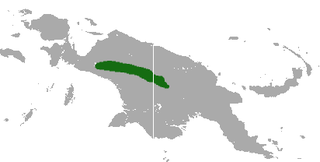
Tree-kangaroos are marsupials of the genus Dendrolagus, adapted for arboreal locomotion. They inhabit the tropical rainforests of New Guinea and far northeastern Queensland, along with some of the islands in the region. Most tree-kangaroos are considered threatened due to hunting and habitat destruction. They are the only true arboreal macropods.

Macropodidae is a family of marsupials, commonly known as kangaroos, wallabies, tree-kangaroos, wallaroos, pademelons, quokkas, and several other terms. These genera are allied to the suborder Macropodiformes, containing other macropods, and are native to the Australian continent, New Guinea and nearby islands.

The dingiso, also known as bondegezou, is a species of tree-kangaroo endemic to Papua Province central on New Guinea island, in northeastern Indonesia.

Matschie's tree-kangaroo, also known as the Huon tree-kangaroo is a tree-kangaroo native to the Huon Peninsula of northeastern New Guinea island, within the nation of Papua New Guinea. Under the IUCN classification, Matschie's tree-kangaroo is an endangered species. The scientific name honours German biologist Paul Matschie. The indigenous population refers to it as a Boongarry.

Goodfellow's tree-kangaroo also called the ornate tree-kangaroo, belongs to the family Macropodidae, which includes kangaroos, wallabies and their relatives, and the genus Dendrolagus, with eleven other species. The species is native to the rainforests of New Guinea, and the border of central Irian Jaya in Indonesia. Under the IUCN classification, the species is listed as endangered, which is a result of overhunting and human encroachment on their habitat. They are named after British zoological collector Walter Goodfellow.

The Torricelli Mountains are a mountain range in Sandaun Province, north-western Papua New Guinea. The highest peak in the range is Mount Sulen at 1650 meters. The Bewani Mountains are located to the west, and the Prince Alexander Mountains are located to the east. To the north, the mountains slope down to the Pacific Ocean, and to the south lies the basin of the Sepik River.

Lumholtz's tree-kangaroo is a heavy-bodied tree-kangaroo found in rain forests of the Atherton Tableland Region of Queensland. Its status is classified as near threatened by the IUCN, and authorities consider it as rare. It is named after the Norwegian explorer Carl Sofus Lumholtz (1851–1922), who was the first European to record a specimen in 1883. The local indigenous Dyirbal and Yidiny language name may have been either "mabi" or "mapi".

Bennett's tree-kangaroo is a large tree-kangaroo. Males can weigh from 11.5 kg up to almost 14 kg, while the females range between about 8 to 10.6 kg. They are very agile and are able to leap 9 metres (30 ft) down to another branch and have been known to drop as far as 18 metres (59 ft) to the ground without injury.

The golden-mantled tree-kangaroo is a species of tree-kangaroo endemic to the Northern New Guinea montane rain forests ecoregion of the island.

Doria's tree-kangaroo is a tree-kangaroo endemic to Papua New Guinea.

The grizzled tree-kangaroo is a small arboreal species of marsupial in the family Macropodidae. It is found in foothill forests of northern and western New Guinea and is indigenous to some of the offshore islands.

The tenkile, also known as Scott's tree-kangaroo, is a species of tree-kangaroo in the family Macropodidae. It is endemic to a very small area of the Torricelli Mountains of Papua New Guinea. Its natural habitat is subtropical or tropical dry forests. It is threatened by habitat loss and by hunting. The tenkile is listed as endangered due to hunting and logging activities in Papua New Guinea. The tenkile is hunted for its meat, and is the main protein source for the residents of Papua New Guinea. The population of Papua New Guinea has increased in recent years due to improvements in healthcare; therefore increasing need in tenkile meat which means that more tenkiles are being hunted. Additionally, tenkiles are poached for their fur and are captured and sold as a part of the illegal pet trade. Domesticated dogs also hunt tenkiles. Deforestation in Papua New Guinea affects all tree-Kangaroos, however industrial logging that occurs in the Torricelli Mountain Range decreases the species' already restricted habitat. The Torricelli Mountain Range faces additional deforestation due to the timber industry, and the production of coffee, rice and wheat.

The lowlands tree-kangaroo or lowland tree-kangaroo is a species of tree-kangaroo in the family Macropodidae.

The ursine tree-kangaroo is a species of marsupial in the family Macropodidae. It is endemic to the Vogelkop and possibly the Fakfak Peninsulas, West Papua, Indonesia. Other common names for this species include the black tree-kangaroo, the Vogelkop tree-kangaroo and the white-throated tree-kangaroo. It is threatened by habitat destruction and is listed as "vulnerable" by the International Union for Conservation of Nature.

Seri's tree-kangaroo is a species of tree-kangaroo native and endemic to montane forests of west-central New Guinea. Seri's tree-kangaroo was originally considered to be a subspecies of Dendrolagus dorianus, but was elevated to species in 2005 by Groves.

Dendrolagus notatus, the ifola or ifola tree kangaroo, is a species of marsupial in the family Macropodidae. It is endemic to Papua New Guinea where it is found in high elevations of the central mountains. It is threatened by habitat loss and hunting for food with dogs by local people. The species is usually considered a subspecies of Dendrolagus dorianus but has recently been considered as a separate species by Helgen in 2007.
Walter Goodfellow (1866–1953) was a British zoological collector and ornithologist.

The Wondiwoi tree-kangaroo is a mammal species in the genus Dendrolagus. It was known until recently from a single specimen which was collected in 1928. The only known specimen is a male weighing 9.25 kilograms (20.4 lb). D. mayri was located in the Wondiwoi Peninsula of West Papua at an elevation of 1,600 metres (5,200 ft) within montane forest. It is thought that the Wondiwoi tree-kangaroo could occupy an area of 300 square kilometres (120 sq mi). Global Wildlife Conservation, the wildlife conservation charity, lists the Wondiwoi tree-kangaroo as one of their "25 most wanted lost species".




















